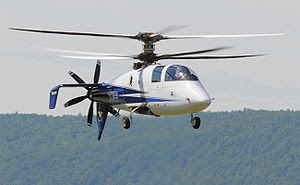The Department of Defense has been trying to make a faster and more capable helicopter for many years now. The Osprey Tilt Rotor is one of the ways that they were able to make an aircraft with the vertical take off and landing capabilities of a helicopter and the fast flight of a fixed wing aircraft.
Although the Osprey has had its share of problems, we won't go into that today.
So that brings us to the Sikorsky X2. The X2 is a technology demonstrator from helicopter pioneers Sikorsky and is still in testing. It differs from most traditional helicopters in that it has two blades on top of each other that spin in opposite directions. This design has been used on other helicopters, notably the Russian Ka-50 Black Shark attack helicopter. However the X2 also incorporates an auxiliary propeller on the tail to increase its speed in forward flight. The rear propeller is not a new idea either and had been a feature on the AH-56 Cheyenne helicopter. In addition to the obvious changes, it also makes use of technologies gleaned from the canceled Comanche Helicopter project such as the composite rotor blades and an advanced transmission. The X2 also uses of improved set of fly by wire controls developed for the Cypher VTOL UAV.
The X2 will likely not see any military service for some time though. The Osprey first flew in 1985, and was not really used until this year. Hopefully the X2 will have an easier time working out its bugs. When it does enter service, it will bring capabilities that no one in the world can match. (For now)


_4017.jpg)




Just wanted to clarify your comment about the advancing tip speed limitation for most rotorcraft. For normal helicopters, the primary level flight speed limitation is just the drag of the airframe and rotor increasing far faster than one can produce forward thrust with a rotor. This explains the "compound" nature (the prop on the back) to direct more energy to pure thrust than one can produce with the rotor disk alone. You'll also notice how "clean" the X2 is, including faired rotorhead to reduce drag. The tip speed issue comes into play at higher speeds than most helos can achieve under normal level flight conditions. The contra-rotating rotor does two things to avoid this, first, it slows down at very high forward speed to reduce the tip velocity (to keep it subsonic) in comparison to the aircraft speed and second, since there is always one side of the two rotors moving forward, it prevents assymetry of lift produced by the retreating side of the rotor disk.
ReplyDelete. . . and I quite agree, the X2 has huge potential.
Another interesting thing about it, it is being developed by company funds only - probably a reaction to Pentagon "suits" who are constantly trying to "Sovietize" and centralize US rotary wing industry. Of course, with DoD civilian "experts" directing it all from the 3rd floor of the Pentagon - this drives our military guys and industry insane - so, it forces the company to forego DoD funding, extends development time, slows innovation, but we have to do it that way, to avoid getting F'd with and having OSD dweebs screw it up.
Thanks for the info, Man you should write your own blog. Seriously, you clearly know more about this than I do. I just read that shit about the rotors on wikipedia.
ReplyDelete